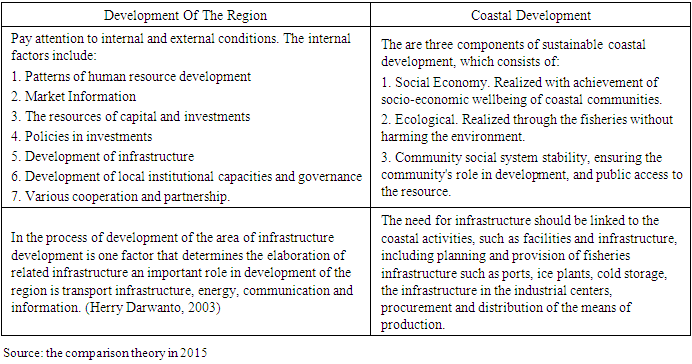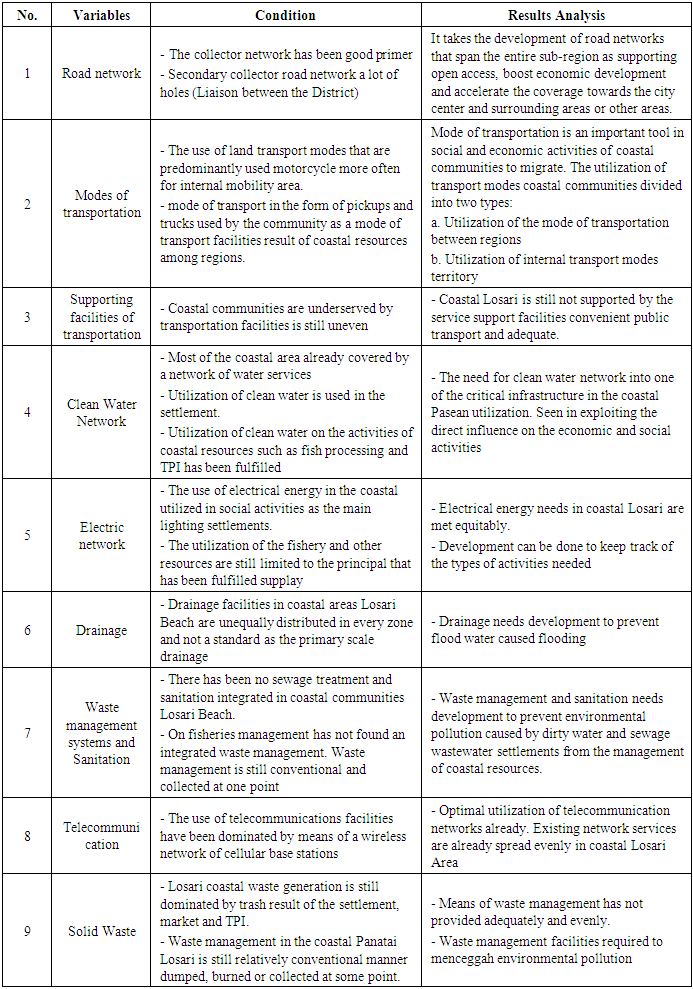-
Paper Information
- Paper Submission
-
Journal Information
- About This Journal
- Editorial Board
- Current Issue
- Archive
- Author Guidelines
- Contact Us
American Journal of Economics
p-ISSN: 2166-4951 e-ISSN: 2166-496X
2019; 9(6): 328-332
doi:10.5923/j.economics.20190906.07

Carrying Infrastructure Capacity Planning for the Development of Losari Coastal Area in Makassar City
Andi Mappalalogau Tantu
Kementerian PUPR-Satuan Kerja Penyediaan Perumahan Sulawesi Selatan
Correspondence to: Andi Mappalalogau Tantu, Kementerian PUPR-Satuan Kerja Penyediaan Perumahan Sulawesi Selatan.
Copyright © 2019 The Author(s). Published by Scientific & Academic Publishing.
This work is licensed under the Creative Commons Attribution International License (CC BY).
http://creativecommons.org/licenses/by/4.0/

Infrastructure planning in coastal areas will be effective when utilizing the potentials as a basis for the development. The results of research related to planning infrastructure carrying capacity for the development of Losari coastal area in Makassar City, indicate, among other things: (1). Availability of infrastructure in coastal areas is already quite complete in Losari Beach. But the unfortunate thing is the presence of some infrastructure functions still can not be utilized optimally and sustainably, (2). Mode of transportation is an important tool in social and economic activities of coastal communities to migrate. The utilization of transport modes coastal communities divided into two types: (a). Utilization mode of transportation between regions and (b). Utilization of internal transport modes territory. The recommendations can be given based on the results of this study are as follows: (1). As a baseline or reference by Makassar City Government to undertake infrastructure development of coastal areas to support the fisheries sector and trade in services with consideration of several aspects that have been planned, (2). Related determining infrastructure needs, the need for cooperation between the Government of Makassar City with a buffer area or hinterland region and (3). There needs to be further study of the coastal areas of infrastructure development to support the fisheries sector and trade in services.
Keywords: Infrastructure and Regional Planning of Coastal Areas
Cite this paper: Andi Mappalalogau Tantu, Carrying Infrastructure Capacity Planning for the Development of Losari Coastal Area in Makassar City, American Journal of Economics, Vol. 9 No. 6, 2019, pp. 328-332. doi: 10.5923/j.economics.20190906.07.
Article Outline
1. Introduction
- Infrastructure has a very broad role and includes a wide range of contexts in development, either in the physical context of the environmental, economic, social, cultural, political, and other contexts. This role certainly will experience the difference for each type of infrastructure, particularly the magnitude of the effect caused by the diversity of function of the infrastructure in each context. Infrastructure is a drive wheel of economic growth. In macroeconomic availability of infrastructure services affects the marginal productivity of private capital, while the micro-economic context, the availability of infrastructure services affects the reduction of production costs (Gie in Haris, 2009).Regional planning is a concept that integrates with the development of the region. Regional development planning is defined as an application attempts a theoretical framework in economic policy and programs contained therein, the consideration of areas that combine aspects of social and environmental aspects in order to achieve optimal community welfare and sustainable (Dahuri, 2004).In early 2010, an estimated 50-70% of the world population live in coastal areas, and at the end of the 20th century, more than three-quarters of the world's population will live in coastal areas (Kodoatie and Sjarief, 2010). According RTRW South Sulawesi, Makassar City is included in RAC (Regional Activity Centers). Metro City area of Napier that have been classified as RAC has 3 service functions within the scope of the province. Meanwhile, in the direction of the development of coastal areas, Metro City Makassar aimed to develop supporting infrastructure communication among coastal areas in South Sulawesi province, improve the quality and quantity of infrastructure in coastal areas.General policy plan urban system (urban system) Spatial Makassar City in 2012 to 2032, as the Regional Activity Center and the Center for Regional Development. (Strategic Area Development Masterplan in 2012). Referring Zoning Plan Coastal Zone Area in Makassar City, indicate utilization of zoning is directed to development activities tourism coastal ensure Activity Center Region, port development, the development of electrical energy, industrial development of coastal and business development of fisheries, seaweed cultivation, means catching fishing, industrial centers of culture and fish processing, and the development of aquaculture business. The coastal area development must be supported by adequate infrastructure.Sufficient and adequate infrastructure will be the basis of development so that all programs can be develop optimally in this coastal region. In fact, the existing infrastructure in coastal areas Losari is still not sufficient. According to the Master Plan for the Development of Strategic Coast Area of Makassar In 2012, there are problems, such as the level of the community's economy is still low, the inaccessibility of the entire community with clean water, still common coastal erosion due to drainage that is not permanent, the waste which still has not spread as well as the condition of the road network that still not good.Therefore, it makes the infrastructure problems that exist in the Losari Coastal Zone in Makassar City, efforts to infrastructure development of coastal areas so that the utilization of coastal resources can be optimized and infrastructure needs can be fulfilled to support the communication among coastal regions between areas in South Sulawesi province and inter island located in eastern Indonesia.
2. Literature Review
- 1. Sustainable Coastal Zone Development According to (Wiyana, 2014), an activity is said to be sustainable if it is in the nature of the sustainability of development activities, namely:a. Economically viable: a development activity should be led to economic growth, maintenance capital (capital maintenance), and the use of resources and efficient investment.b. Ecologically sustainable: development activities should be able to maintain the integrity of the ecosystem, maintain the carrying capacity of the environment and conservation of natural resources, including biological diversity (biodiversity).c. Sustainable social and political: the development activities that can equalize the results of development, social mobility, social cohesion, community participation, community empowerment (dekratisasi), social identity, and institutional development.Furthermore, Redclift (1987) in Kay and Alder (2005) reveals that sustainable development requires a broader outlook in terms of economy and ecology, compared to most practitioners of various disciplines that are ready to be recognized, which is accompanied by a guarantee policy to ensure that development is 'unsustainable'. According to Charles (2001) in the Satria (2009), the dimension of community empowerment refers to the concept of sustainability is as follows:a. Embodied ecological sustainability through the fisheries without harming the environment and utilization of coastal resources melibihi no environmental capacity. b. Social and economic sustainability Embodied by the achievement of socio-economic wellbeing of coastal communities c. Embodied community sustainability with social system stability, ensuring the community's role in development, and public access to the resource, either for the utilization and management. d. Sustainability is a prerequisite for the achievement of the institution the three dimensions of sustainability before. Covering political institutions (village bureaucratic capability), socio-economic institutions (financial institutions, markets, etc.), and institutional resources (institute resource managers).Sustainability socially related economic activities of coastal communities that are identical to the utilization of marine resources so that the needs of the infrastructure should be linked to the activity of the coast, such as facilities and infrastructure (infrastructure), including planning and provision of fisheries infrastructure such as ports, ice plants, cold storage, infrastructure in the industrial centers, 19 procurement and distribution of the means of production (such as fuel, seed, machinery and gear, as well as system information about new technologies and management systems efficient business by (Wiranto, 2004) is one of the interrelated components in the development and management of coastal resources a comprehensive and integrated.
|
 | Figure 1. The relationship between social systems, economic, infrastructure and natural environment of harmony (Grig, 1988) |
3. Research Methods
- Three elements are selected as stakeholders in participatory mapping activities related to the carrying capacity of infrastructure planning studies on developing this coastal region are:a. The government, namely: Development Planning Agency (Bappeda) Makassar City, Department of Culture and Tourism, Department of Marine and Fisheries, and Environmental Control Office (Kapedal).b. Private parties: Fishermen Group, Society of businesses Losari restaurant, Resort owners and cottage associations, small businesses and non-formal.c. Parties society: Tourism Awareness Group Losari Beach, Community environmentalists.
4. Research Result
- Availability of infrastructure in coastal areas is already quite complete in Losari Beach. But the unfortunate thing is the presence of some of the infrastructure that functions still can not be utilized optimally and sustainably. It thus expressed by some stakeholders of the Department of Tourism and Bappeda Makassar City with the following statement:"The condition of the parking area is not able to accommodate capacity during peak seasons, transporting waste less quickly during holidays, wastes fish are often seen on the back of the stall / retsoran cause environmental visibly dirty (Head of Head of Sub-Division of Land and Spatial Agency Urban planning and Development Makassar City). " Aspects of this infrastructure availability leads to the condition of existing facilities and infrastructure relating to the potential and problems associated with the carrying capacity of the environment in the study area, the following explanation: a. Restaurants considered adequate (permanent) and the supply side is still cater for the number of visitors that much. But the issue is the environmental problems often arise because of solid waste such as garbage. Other problems are associated with eating stall trader in coastal areas, which led to the impression of an increasingly crowded.b. Supply of clean water. Abundant supply of clean water, which is 10,800 liters / second, so it can be used to meet the tourism activities. To the above mentioned respondents who were in Bappeda peneiti Metro City Makassar further disclosed through the following statement:"The condition of good clean water supply. Their water treatment processes and purifies water down the river to be sterile and then duct to the homes of residents. But the name of the underground river water would have been mixed with the bacteria. (Head of Sub-Division of Land and Spatial Planning, Bappeda of Metro City Makassar). "Existing condition of infrastructure in the coastal area of Losari Beach in Makassar as an instrument carrying capacity for the development of coastal areas. The process of identifying the existing condition of infrastructure is done by using descriptive method where variables are obtained from the literature review will be blasted with policy and legislation related. Variables that are similar are grouped together and will form some infrastructure. The results of the identification of infrastructure carrying capacity of the coastal region of Losari Beach as follows:
|
5. Conclusions and Suggestion
- The results of research related to planning infrastructure carrying capacity for the development of coastal areas in the City Losari Makassar City, indicate, among others, namely:1. Availability of infrastructure in coastal areas is already quite complete in Losari Beach. But the unfortunate thing is the presence of some of the infrastructure that functions still can not be utilized optimally and sustainably, Priority development and management of coastal areas in Losari Beach against the three sectors that have existing use is (1). beaches, (2). fisheries, and (3). mariculture.2. Mode of transportation is an important tool in social and economic activities of coastal communities to migrate. The utilization of transport modes coastal communities divided into two types: (a). Utilization mode of transportation between regions and (b). Utilization of internal transport modes territory.The recommendations can be given based on the results of this study are as follows: 1. As a baseline or reference by Makassar City Government to undertake infrastructure development of coastal areas to support the fisheries sector and trade in services with consideration of several aspects that have been planned.2. Related determining infrastructure needs, the need for cooperation between the Goverment with a buffer area or hinterland region.3. There needs to be further study of the coastal areas of infrastructure development to support the fisheries sector and trade in services.
 Abstract
Abstract Reference
Reference Full-Text PDF
Full-Text PDF Full-text HTML
Full-text HTML
